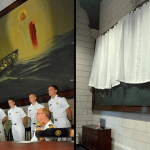I didn’t expect to be saying this, but Prince Caspian is a better movie than 2005’s The Lion, the Witch, and the Wardrobe—and, believe it or not, a more Christian movie.
Gone is the shallow “three cheers for family” prattle of the first film; in Prince Caspian, it’s even suggested that obeying Aslan might be more important than being nice to one’s siblings. Gone is the “just believe in yourself” message that seems to dominate anything Disney has done in recent years; Prince Caspian has the temerity to suggest that humility—or even believing in Someone greater than yourself—might be the better course.
Moreover, as a central concept, Prince Caspian seems to pick up on one of Lewis’s major themes (if not in the book Prince Caspian, it’s one that runs through many of his works): the silliness—and danger—of wanting to be thought grown-up and sophisticated. Lewis wrote in his 1952 essay “On Three Ways of Writing for Children,” “When I was ten, I read fairy tales in secret and would have been ashamed if I had been found doing so. Now that I am fifty I read them openly. When I became a man I put away childish things, including the fear of childishness and the desire to be very grown up.”
Peter is the most obvious embodiment of this theme in the film: in an early scene, British soldiers break up a fist-fight between Peter and another boy in a tube station, telling Peter scornfully, “Act your age.” Unfortunately, he is acting his age, which is precisely the age at which one desperately wants to be grown up and ends up acting petulant and irresponsible instead. (I don’t think I’m ever going to like actor William Moseley’s version of Peter, but at least he’s not as whiny here as he was in the first film.)
Peter also seems to have developed the “adult” idea that taking action himself is preferable to waiting around for Aslan to come and rescue them. News flash: he’s wrong. The movie effectively uses emotionally wrenching scenes of a battle plan gone awry—and the deaths of noble Narnians—to show how misled Peter has been.
But it’s not just Peter—many of the characters learn to embrace childlike belief instead of supposedly mature self-reliance. Caspian, the young Telmarine prince, escapes from his uncle, the usurper Lord Miraz, only to be captured by creatures he’s been led to believe were fairy tales: Dwarves and Talking Animals, the residents of Old Narnia. Many of the Old Narnians themselves, especially Trumpkin the Dwarf have, through the centuries, begun to doubt the reality of the Kings and Queens of old—and even of Aslan himself, as he has apparently been absent from Narnia for 1300 years. If he does exist, he seems to have abandoned the Narnians.
I do wish the film had shown more of the loyalty of the Narnians who do still believe in Aslan, but it’s an effective portrayal of the crisis of faith people often undergo when they feel abandoned by God. Some try to rely on themselves, and some turn to the darker powers that often seem like they’re more in control of things. Both Caspian and Peter, after their failed invasion of the Telmarine castle, are tempted to turn to a nearer evil power instead of trusting in the seemingly distant Aslan.
Lucy, the youngest Pevensie sibling, is as stalwart in her faith as ever—and to the one who believes, more is revealed. She’s the only one who sees Aslan initially, as he guides the children on the journey (or is willing to guide them, if they would only listen to the most childlike one among them). Young Georgie Henley remains a great Lucy, conveying wonder and an amazing ease in Aslan’s presence without coming across as too twee.
(The one moment in the film that struck me as travesty and made me claw the arm of my seat—and of my husband—in irritation was the implication that one of Lucy’s Aslan-sightings was a dream. This may not be troublesome to viewers who don’t know that this suggestion never occurs in the book, for of course God does speak to people in dreams. I find the “it’s a dream” explanation troubling, but, since Aslan does appear in the (very real) flesh later on, it’s not as bad as it could have been.)
The film, through Lucy, raises the question of whether things might have gone better—if Narnian lives might have been spared—if everyone had had more faith in Aslan from the beginning. There’s a sense running through the battles—and yes, they are long—that, as noble as the self-sacrificial fighting may be, it might all be unnecessary. It’s a courageous and countercultural idea to include in the movie, especially for a director who clearly likes to film battles.
As far as the aesthetics of the film, the CGI critters are much more convincing here than in The Lion, the Witch, and the Wardrobe. The valiant mouse Reepicheep is a highlight. In the 1300 years since the events of the first movie, fauns seem to have developed amazing jumping abilities, which are pretty cool to watch. The New Zealand scenery gets to play a more impressive role here—or at least more impressive to people who prefer green, growing things to endless snow.
The Narnia movie series may never get over one of its biggest visual hurdles, which is that it often looks silly for children to be fighting against adults, particularly in hand-to-hand combat. Frankly, the fighting of tiny CGI mice looks more convincing. Trying to focus on the boys’ swordsmanship is, I think, a mistake—because it calls attention to the ridiculousness of children in battle. Treating these scenes with attempted realism not only fails aesthetically but also fails to remind us that the children aren’t fighting through their own strength. It’s only through Aslan that they can do the impossible.
Overall, though, through the positive example of Lucy and the negative example of other characters, the movie comes across in defense of childlike faith—a faith eventually vindicated. It’s such a different (and welcome) focus from the first film that I wonder what happened. Whatever the screenwriters’ and director’s intent, Prince Caspian ultimately succeeds—despite some flaws—as a film because it seems to have taken the importance of the “old stories” to heart. A young man named Clive Staples Lewis, when he gave up his fashionable adolescent skepticism, began to read the stories and myths that enchanted him in his childhood—and, as a result, found himself at the feet of Jesus. In some ways, that’s where the movie Prince Caspian ends up too, whether intentionally or not.















